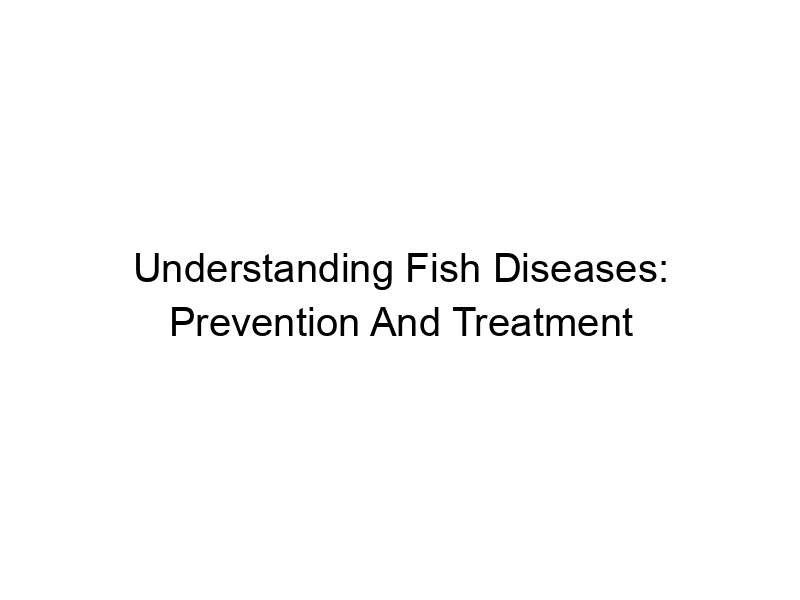Keeping your aquarium thriving requires more than just clean water and regular feeding. A crucial aspect of fishkeeping is understanding and managing potential diseases. Understanding Fish Diseases: Prevention and Treatment is essential for any responsible fish owner, whether you’re a seasoned aquarist or just starting your aquatic journey. This comprehensive guide will equip you with the knowledge to prevent common ailments, identify symptoms, and implement effective treatments to keep your finned friends healthy and happy. You’ll learn about various diseases, preventative measures, treatment options, and how to maintain a healthy aquarium environment.
Fish diseases are ailments affecting the health and well-being of fish, ranging from minor infections to life-threatening conditions. These can be caused by bacteria, viruses, parasites, fungi, or environmental factors. Identifying the cause is critical for effective treatment.
Bacterial
infections often manifest as fin rot, cloudy eyes, lesions on the body, or lethargy. Common culprits include Aeromonas, Pseudomonas, and Vibrio bacteria. Early detection is key to successful treatment.
Viral Infections in Fish: Prevention and Treatment
Recognizing Viral Infections
Viral infections can be challenging to treat, often leading to systemic problems. Symptoms can vary greatly depending on the specific virus, but may include skin lesions, internal organ damage, or behavioral changes. Prevention through quarantine and maintaining water quality is crucial.
Parasitic Infections in Fish: A Detailed Look
Identifying Different Types of Parasites
Parasitic infections are common in aquariums and can be caused by various organisms like ich (white spot disease), flukes, and worms. These parasites can attach to the skin, gills, or internal organs, causing irritation, damage, and potentially death. Treatment often involves medication, but quarantine is crucial.
Fungal Infections in Fish
Identifying and Treating Fungal Infections
Fungal infections often appear as fuzzy growths on the fish’s body or fins. These infections thrive in poor water quality and can quickly spread through an aquarium. Treatment typically involves antifungal medications and improved water parameters.
Environmental Factors Contributing to Fish Diseases
Water Quality and Its Impact
Poor water quality is a major contributor to fish diseases. Factors like high ammonia, nitrite, or nitrate levels, improper pH, and insufficient oxygen can weaken the immune system, making fish susceptible to infections. Regular water changes and monitoring of water parameters are essential.
Nutrition and its Role in Fish Health
The Importance of a Balanced Diet
Providing a balanced and nutritious diet is crucial for maintaining a strong immune system in fish. A diet lacking essential vitamins and minerals can lead to deficiencies and increased susceptibility to diseases. A variety of high-quality foods is recommended.
Quarantine: A Crucial Step in Preventing Disease Spread
Establishing a Quarantine Tank
Quarantine is essential for new fish or fish exhibiting symptoms of illness. This prevents the spread of disease throughout the main aquarium. A separate quarantine tank with appropriate filtration and aeration is necessary.
Identifying Symptoms of Fish Disease
Common Signs of Illness
Recognizing the early signs of illness is crucial for timely intervention. Symptoms can include lethargy, loss of appetite, unusual swimming behavior, discoloration of the skin or fins, and visible parasites or lesions.
Treatment Options for Fish Diseases
Medication and Dosage
Various medications are available to treat specific fish diseases, but it is vital to correctly identify the disease before administering any treatment. Following dosage instructions carefully is essential to avoid harming the fish.
Natural Remedies for Fish Diseases
Exploring Alternative Treatments
In some cases, natural remedies such as raising the water temperature or adding aquarium salt can help improve fish health and combat certain infections. However, these methods may not be effective for all diseases.
Maintaining Optimal Water Parameters for Fish Health
Monitoring and Adjusting Water Chemistry
Regular monitoring of water parameters, including pH, ammonia, nitrite, and nitrate levels, is essential for maintaining a healthy aquarium environment. Adjustments should be made gradually to avoid shocking the fish.
The Role of Aquarium Filtration in Disease Prevention
Understanding Filtration Systems
Effective filtration removes waste products and harmful substances from the water, contributing to a healthier environment for fish. Regular maintenance of the filter is crucial to ensure its proper functioning.
Choosing the Right Fish for Your Aquarium
Compatibility and Species Selection
Choosing compatible fish species is crucial for a harmonious and healthy aquarium. Fish should be selected based on their size, temperament, and water parameter requirements to prevent aggression and disease outbreaks.
Stress and Its Impact on Fish Immunity
Minimizing Stress Factors
Stress can significantly weaken a fish’s immune system, making it more susceptible to diseases. Factors like overcrowding, sudden changes in water parameters, or aggressive tank mates can contribute to stress. Providing a stable and comfortable environment is crucial.
Preventing Fish Diseases: A Proactive Approach
Implementing Preventative Measures
Proactive measures, such as regular water changes, appropriate filtration, proper nutrition, and quarantine of new fish, are crucial in preventing disease outbreaks. A clean and well-maintained aquarium is the best defense against illness.
Advanced Techniques for Disease Management
Specialized Treatments and Procedures
For advanced cases of fish disease, specialized treatments or procedures may be required. Consulting with an experienced aquarist or veterinarian is recommended for complex situations requiring more expertise.
Frequently Asked Questions
What are the most common signs of fish disease?
Common signs include lethargy, loss of appetite, unusual swimming behavior, fin clamping, rapid gill movement, cloudy eyes, skin lesions, and visible parasites.
How often should I perform water changes in my aquarium?
The frequency of water changes depends on the size of the tank and the bioload (number of fish and other organisms). Generally, 25-50% water changes weekly are recommended.
What is the best way to quarantine new fish?
New fish should be quarantined in a separate tank for at least 2-4 weeks to observe for any signs of disease before introducing them to the main aquarium.
What are some common aquarium parasites?
Common aquarium parasites include ich (white spot disease), flukes, and various types of worms.
How do I treat fin rot?
Fin rot treatment usually involves improving water quality, and sometimes using antibiotics. Specific treatment will depend on the severity and cause.
Can I use human medications to treat fish diseases?
No, human medications are not suitable for treating fish diseases and can be toxic. Use only medications specifically formulated for aquatic use.
What should I do if I suspect my fish has a disease?
Isolate the affected fish immediately, observe its symptoms carefully, and consult a reputable source for treatment advice, such as an experienced aquarist or veterinarian.
Final Thoughts
Understanding and preventing fish diseases is a crucial aspect of responsible fishkeeping. By implementing the preventative measures discussed in this guide, you can significantly reduce the risk of disease outbreaks in your aquarium. Remember, early detection and appropriate treatment are key to successfully managing fish health. Maintaining optimal water quality, providing a balanced diet, and minimizing stress are essential for creating a thriving aquarium environment where your fish can flourish. Don’t hesitate to seek advice from experienced aquarists or veterinarians if you encounter any problems. A healthy aquarium is a happy aquarium! Start creating that today.




